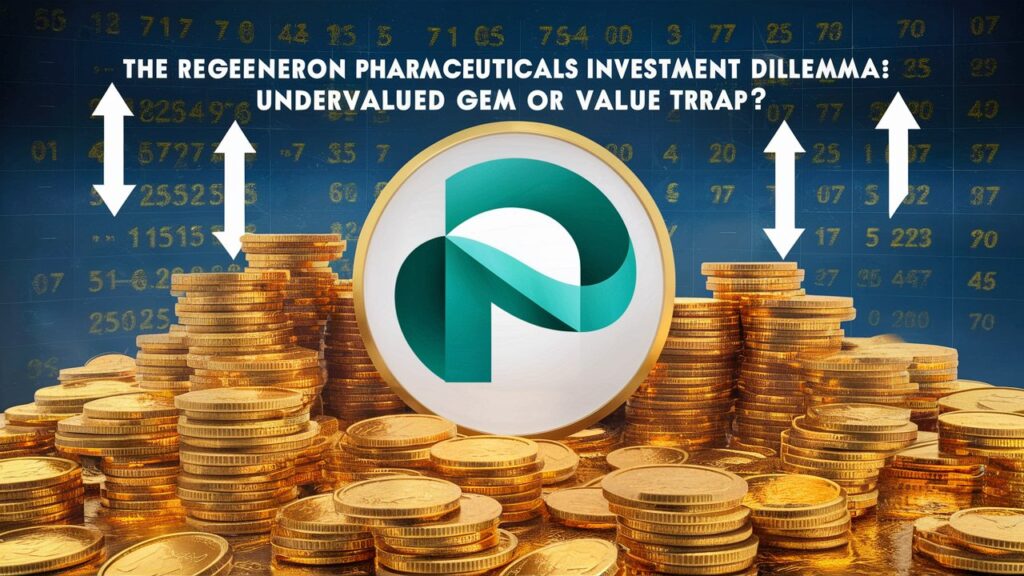Introduction: A Biotech Powerhouse at a Crossroads
Regeneron Pharmaceuticals (NASDAQ: REGN) stands at a critical juncture, with its stock price plunging nearly 60% from its August 2024 peak of $1,211 to approximately $520 as of June 2025 357. This dramatic decline stems from a perfect storm of challenges: the high-profile failure of its COPD drug itepekimab in one of two Phase 3 trials, ongoing competitive pressures facing its flagship Eylea franchise, and a recent FDA rejection of the Eylea HD pre-filled syringe due to third-party supplier issues 135. Yet beneath these headwinds lies a company with robust profitability metrics, a fortress balance sheet, and blockbuster growth engines like Dupixent. This comprehensive analysis examines whether REGN’s current valuation represents a generational buying opportunity or conceals deeper structural risks that justify market pessimism.
Eylea Franchise Challenges: Navigating the Storm
Regeneron’s ophthalmology franchise faces multifaceted pressures that have significantly impacted its financial performance. First quarter 2025 results revealed a stark 26% year-over-year decline in combined Eylea and Eylea HD U.S. net sales, dropping to $1.04 billion from $1.4 billion in Q1 2024 2. This deterioration stems from three interconnected factors: intensified competition from Roche’s Vabysmo and compounded bevacizumab (a low-cost alternative), patient affordability constraints driving adoption of cheaper alternatives, and the ongoing transition of patients from original Eylea to the higher-dose Eylea HD formulation 2. While Eylea HD demonstrated promising 54% year-over-year growth to $307 million, this expansion has been insufficient to offset the erosion of the legacy product. The recent FDA Complete Response Letter for the Eylea HD pre-filled syringe—attributed to a third-party component supplier rather than product efficacy or safety—adds near-term commercial complexity 12. Management anticipates resolution could occur relatively swiftly if the supplier adequately addresses FDA concerns, but timing remains uncertain.
Dupixent: The Unstoppable Growth Engine
In stark contrast to Eylea’s struggles, Regeneron’s immunology powerhouse Dupixent (developed with Sanofi) continues its remarkable ascent. Global net sales surged 19% year-over-year to $3.67 billion in Q1 2025, maintaining its trajectory toward potential peak sales exceeding $20 billion annually 23. The drug’s label expansion strategy has been instrumental to this growth, with recent FDA approvals for chronic spontaneous urticaria (CSU) and priority review designation for bullous pemphigoid (target action date: June 20, 2025) 2. Notably, Dupixent became the first biologic approved for COPD in Japan in March 2025—a significant milestone despite the separate Phase 3 setback for itepekimab in COPD. Analysts highlight that Dupixent alone could justify Regeneron’s current $56 billion market capitalization within several years, effectively assigning minimal value to the rest of the pipeline and existing portfolio 35.
Pipeline Progress Beyond Dupixent: Hidden Gems Emerge
Beyond its commercial anchors, Regeneron boasts over a dozen late-stage programs demonstrating strategic diversification:
- Oncology Advancements: The company achieved EU approval for Lynozyfic™ (linvoseltamab) in relapsed/refractory multiple myeloma and submitted U.S./EU applications for Libtayo® in adjuvant cutaneous squamous cell carcinoma (CSCC)—a setting with no approved immunotherapies 2. Both bispecific antibodies (odronextamab for lymphoma and linvoseltamab) have FDA target action dates in July 2025.
- Metabolic Breakthroughs: A strategic licensing agreement with Hansoh Pharma secured ex-China rights to a Phase 3-ready GLP-1/GIP receptor agonist, positioning Regeneron to compete in the explosive obesity market 13. Early data suggest potential advantages in preserving lean muscle mass during weight loss.
- Gene Therapy Milestones: Updated Phase 1/2 data for DB-OTO (otoferlin gene therapy) showed 11 of 12 treated children achieving significant hearing improvements, including near-normal auditory function in one patient 2.
- Cardiovascular and Rare Disease Expansion: Phase 2 trials initiated for NPR1-targeting antibodies in hypertension and sepsis-induced hypotension, while orphan drug designation for mibavademab (leptin receptor agonist) in lipodystrophy underscores progress in niche markets 2.
*Table: Regeneron’s Key Pipeline Catalysts (2025-2026)*
| Asset | Indication | Development Stage | Catalyst Timing |
| Dupixent | Bullous Pemphigoid | FDA Priority Review | PDUFA June 20, 2025 |
| Odronextamab | Follicular Lymphoma | FDA Review | Target Action July 30, 2025 |
| Linvoseltamab | Multiple Myeloma | FDA Review | Target Action July 10, 2025 |
| EYLEA HD | Retinal Vein Occlusion/Monthly Dosing | FDA Priority Review | Target Action August 19, 2025 |
| Itepekimab | COPD | Phase 3 (AERIFY-2 ongoing) | Data 2026 |
| GLP-1/GIP Agonist | Obesity/Metabolic Disease | Phase 3-ready | Trial Initiation 2025 |
Financial Resilience: Profitability Amidst Transition

Regeneron’s financial metrics reveal exceptional operational discipline despite revenue headwinds. While Q1 2025 total revenues declined 4% year-over-year to $3.03 billion, the company maintained GAAP net income of $809 million—a 12% increase—and generated $4 billion in operating cash flow over the past four quarters 234. Its net income margin of 31.9% dwarfs the S&P 500 average of 11.6%, reflecting premium pricing power and manufacturing efficiency 3. The balance sheet remains fortress-like with $8.3 billion cash against $2.7 billion debt, yielding a negligible debt-to-equity ratio of 4.2% versus 19.9% for the broader market 34. This financial flexibility enables aggressive pipeline investment, including a $256 million acquisition of 23andMe to bolster genetic research capabilities and a 10-year manufacturing partnership with FUJIFILM Diosynth to double U.S. production capacity 12.
Valuation Disconnect: Fundamentals Versus Sentiment
Current market sentiment appears disconnected from Regeneron’s underlying financial strength and growth potential. At approximately 4.6x sales and 13.2x trailing earnings, REGN trades at discounts to both its historical multiples and broader market indices 348:
- Price-to-Earnings: 13.2x TTM (vs. S&P 500: 26.4x)
- Price-to-Sales: 4.2x TTM (vs. 5-year average: ~6x)
- Price-to-Free-Cash-Flow: 16.4x (vs. S&P 500: 20.5x)
Benjamin Graham-inspired deep value analysis highlights REGN as fundamentally sound (86% score) based on earnings stability, low debt, and robust liquidity, though it fails the price-to-book test due to significant intangible assets 11. Analyst price targets reflect this divergence: UBS maintains a neutral rating with a reduced $560 target 1, while long-term forecasts project potential upside exceeding 170% to $1,415 within 12 months based on pipeline catalysts 8.
Technical Analysis: Bearish Signals Dominate
Technical indicators currently skew bearish despite REGN’s fundamental appeal. The stock trades below all key moving averages (50-day: $557; 100-day: $612; 200-day: $738), confirming a strong downtrend 48. Oscillators send mixed signals—RSI at 43 suggests neither overbought nor oversold conditions, but STOCHRSI at 83 implies potential near-term exhaustion of selling pressure 8. Volume patterns show distribution (higher volume on down days), though the 14-day ADX reading of 21 indicates a lack of strong directional conviction 8. For contrarian investors, this technical setup implies accumulation opportunities near $476 (52-week low), but requires patience for sustained recovery above the $600 psychological resistance level.
Risk Factors: Navigating the Minefield
Prospective REGN investors must weigh several material risks:
- Eylea Erosion Acceleration: With biosimilars eligible for U.S. launch in late 2026 following patent litigation settlements, Eylea could face precipitous declines absent successful transition to Eylea HD 2.
- Pipeline Stumbles: Further clinical failures like the itepekimab COPD setback could undermine confidence in Regeneron’s R&D prowess and compound valuation compression 5.
- Regulatory Setbacks: The FDA’s rejection of extended Eylea HD dosing intervals beyond 16 weeks signals heightened scrutiny, potentially limiting commercial differentiation 2.
- Dupixent Dependency: With >100% of Regeneron’s market cap arguably supported by Dupixent’s value, any unexpected safety concerns or reimbursement changes could disproportionately impact valuation 310.
- Macro Sensitivity: Despite historically outperforming during market downturns (25.8% decline during 2022 inflation shock vs. S&P’s 25.4% drop), REGN’s beta of 0.31 may not fully protect against biotech sector volatility 37.
Investment Thesis: Why Now Presents Opportunity
For patient investors, Regeneron represents a compelling risk-reward proposition at current levels. The market appears to be discounting three critical value drivers:
- Dupixent’s Long Runway: With COPD/CSU approvals expanding the addressable market and real-world evidence reinforcing superiority in atopic diseases, Dupixent could sustain >15% growth through 2030 25.
- Pipeline Optionality: The Hansoh GLP-1 agonist provides de-risked exposure to obesity markets, while gene therapy (DB-OTO) and oncology assets (linvoseltamab combinations) offer billion-dollar opportunities currently valued near zero 28.
- Capital Return Potential: With $8.3 billion cash generating minimal returns, Regeneron could initiate dividends beyond its current 0.68% yield or accelerate share repurchases to capitalize on depressed valuations 47.
While near-term volatility is inevitable, management’s strategic pivot toward metabolic disease, gene editing, and T-cell therapies could ultimately transform Regeneron into a more diversified biotech leader trading at a fraction of its intrinsic value.
Conclusion: The Verdict on Regeneron’s Investment Potential
Regeneron Pharmaceuticals embodies the classic contrarian investment: fundamentally strong but sentimentally battered. The 60% price collapse since August 2024 reflects legitimate concerns about Eylea’s decline and pipeline setbacks, yet overlooks Dupixent’s blockbuster trajectory, a maturing oncology franchise, and untapped potential in obesity therapeutics. With the stock trading at just 13x earnings despite 30%+ net margins and a debt-free balance sheet, much of the bad news appears priced in. Investors with 3–5 year horizons stand to benefit from multiple expansion as pipeline assets mature and Eylea erosion stabilizes. While not without risk, REGN below $500 offers asymmetric upside potential rarely seen in large-cap biotech.
Frequently Asked Questions
Q: Why did REGN stock drop 60% from its 52-week high?
A: The decline stems from three primary factors: failure of itepekimab in one of two Phase 3 COPD trials (eliminating $2B–$6B peak sales potential), accelerated erosion of Eylea sales due to competition and affordability issues, and FDA rejection of the Eylea HD pre-filled syringe over third-party supplier concerns 135.
Q: Is Regeneron’s dividend sustainable?
A: Absolutely. With $8.3 billion cash, $4 billion annual operating cash flow, and a payout ratio below 10%, Regeneron’s 0.68% yield is exceptionally secure. The company could sustainably increase dividends given minimal debt (4.2% debt-to-equity) 347.
Q: What upside catalysts could drive REGN higher?
A: Key catalysts include: 1) FDA approvals for Dupixent in bullous pemphigoid (June 2025) and Eylea HD in RVO/monthly dosing (August 2025); 2) Positive Phase 3 data for the Hansoh GLP-1 agonist; 3) Eylea HD syringe resubmission acceptance; and 4) Strategic pipeline partnerships or acquisitions 28.
Q: How does Regeneron’s valuation compare to peers?
A: REGN trades at significant discounts: 13.2x P/E vs. industry median 22x, 4.2x P/S vs. 6.5x sector average, and 16.4x P/FCF vs. 20.5x for S&P 500. Its profitability metrics (32% net margin) also outperform most biotech peers 3411.
Q: What is the biggest threat to Regeneron’s growth?
A: Over-reliance on Dupixent poses the largest risk, as the drug could generate >60% of 2026 revenue. Unexpected safety issues, reimbursement changes, or competitor entrants could disproportionately impact growth. Eylea’s ongoing decline and pipeline failures remain secondary concerns 3510.
